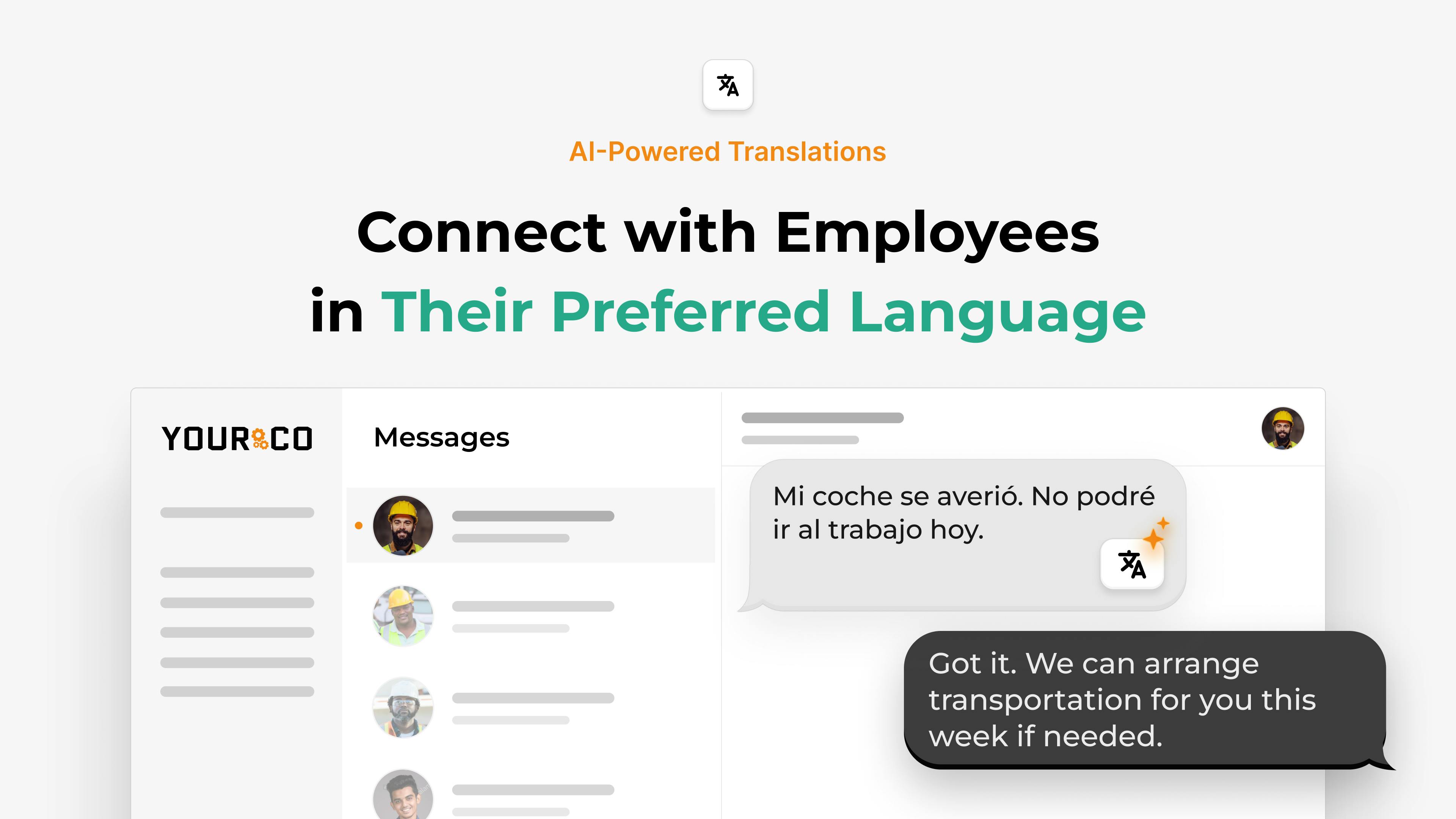Complete Guide to Microlearning in Transportation 2025


Classroom training doesn't always work for transportation teams. High turnover, scattered work sites, and strict regulations make long sessions expensive and hard to organize. Drivers, dockworkers, and dispatchers also don't have the time to sit through hour-long courses. What they need are quick reminders that fit between deliveries and shift changes.
That is where microlearning comes in. Each bite-sized lesson focuses on a single concept and takes only a few minutes, whether it is a short video on load securement or a quick two-question quiz on hours-of-service rules. When delivered by text message, which almost everyone reads, updates reach workers right away when regulations change or new equipment shows up. No one has to be pulled off the floor or gathered into a break room.
This guide shows how to build that kind of system in a practical way. You will learn how to connect micro-lessons to business goals, design for frontline needs, create content quickly, deliver it where workers will see it, and measure the results. By the end, you will have a clear playbook for turning mobile learning into an everyday safety tool.
Connect Your Training to Business Results
The fastest way to prove the value of short-form training is by showing how each lesson tackles a pressing problem on your floor, like fewer injuries, cleaner audits, or lower turnover. Success comes from following a straightforward, goal-first process.
Begin by ranking pain points. Pull data from incident reports, compliance citations, production errors, and exit interviews. Patterns reveal where knowledge gaps hit hardest — maybe forklift bumps on the night shift or missed signatures on bills of lading.
Once you identify the problem, you can match it to the rulebook. Many employers look to OSHA, FMCSA, and DOT guidelines for direction. Break each requirement into one concept per lesson so drivers, pickers, and supervisors learn exactly what they need in three to six minutes.
Transform those lessons into clear objectives using a simple formula: Action verb + measurable target + timeframe + audience + format. For example: "Reduce forklift incidents by 15% in six months by sending five SMS training modules with quizzes to all warehouse operators."
Track progress with clear transportation metrics, such as on-time rates, training completion, or recorded safety incidents.
This approach only sticks when every stakeholder agrees on the finish line. Secure support from floor managers and shift leads by including them in the process:
- Operations lead — owns productivity metrics
- Safety manager — validates risk topics
- Compliance officer — reviews regulatory accuracy
- HR partner — aligns with onboarding and retention goals
- Frontline supervisors — reinforce lessons on the floor
When mobile learning connects to real business metrics and regulatory requirements, every text message serves a clear purpose, and every stakeholder has a reason to support the effort.
Conduct a Learner Analysis of Your Drivers and Warehouse Teams
You can't fix training gaps until you understand who's on the receiving end. Managing a scattered workforce means every lesson needs to work for someone who can only check their phone between delivery stops or during their 15-minute break.
Consider the core personas that represent your team. What do their days look like?
Drivers spend most of their day alone, relying on personal phones between stops while racing against tight delivery windows. They need training that works when they're parked outside a customer site with just enough time to complete something quick.
Warehouse associates face a completely different reality. They're constantly moving, often sharing devices at kiosks, and dealing with noise, safety gloves, and forklifts buzzing around them.
Supervisors split their time between the floor and the office, translating company strategy into day-to-day direction for their teams.
For each persona, map out the practical details that make or break training success:
- Device access: Personal phone, shared tablet, kiosk only
- Language: Primary and secondary languages
- Shift pattern: Days, nights, rotating, overtime peaks
- Education: Reading level, certifications held
- Tech comfort: Text-only, smartphone apps, video familiarity
- Learning obstacles: Dead zones, PPE gloves, limited breaks
Pull real data to validate each persona. Safety logs surface recurring errors or near misses that training should address. Performance reviews highlight skills that separate top performers from everyone else. Exit interviews reveal why previous training didn't stick for people who left.
Tie every finding back to practical design choices. Shorter videos work better in low-bandwidth areas. Larger buttons help when workers wear gloves. Voice-over scripts support team members with lower reading levels.
Language barriers can kill even the best training program. When your loading dock crew speaks Spanish, Polish, and English, one-size-fits-all content leaves people behind. Auto-translation features ensure the same forklift safety reminder reaches every operator clearly. When content feels familiar and readable, completion rates climb and safety rules stick.
Design Your Training Strategy and Content Plan
Building on your learner analysis, map out exactly what content you'll deliver and how it connects to your business goals.
Start with a clear framework: Learning Objective → Content Format → Delivery Method → Success Metric. For example, "Reduce near-miss forklift incidents" → 90-second video → SMS link → 15% drop in reportable events.
Choose formats that fit frontline realities. Short videos, infographics, audio snippets, interactive SMS quizzes, and one-page checklists work well for drivers and warehouse crews who learn during brief breaks. These bite-sized lessons maintain high completion rates. Research indicates modules under ten minutes often see completion rates around 80%, far above traditional training programs.
Design each lesson around a single concept and keep it between three and six minutes. Optimize every detail for phones, as mobile access is critical for scattered teams. This prevents information overload and respects tight shift schedules. Make the takeaway immediately actionable, like "perform a three-point truck entry" rather than a broad "practice safe driving."
Sketch series that address your biggest risk and efficiency opportunities:
- Safety: loading-dock signals, hazardous materials basics, severe-weather protocols
- Compliance: hours-of-service rules, daily inspection checklists, paperwork accuracy
- Operations: pallet jack upkeep, customer-delivery etiquette, fuel-saving driving habits
Space each touchpoint so it sticks. Critical safety rules may follow a 1-day, 7-day, 30-day cadence, while a new customer-service policy might repeat after two and four weeks.
Decide whether to create or curate content using this quick decision path:
- Is the topic company-specific or proprietary? Create.
- Has a reputable source produced compliant, up-to-date material? Curate.
- Does existing content need tweaks for language or relevance? Adapt, then curate.
Following these steps gives you a focused curriculum that frontline teams can finish quickly and apply right away.
Build Content That Gets Used
With your curriculum mapped out, focus on creating content that workers will complete. You don't need to start from scratch. Most transportation teams already have valuable training materials sitting in filing cabinets and computer folders, such as safety manuals, incident reports, toolbox talks, even phone videos captured after a near-miss. Gather these materials and organize them by topic and currency. This simple review helps you spot gaps and avoid recreating content you already have.
Since regulations and workflows change quickly, keeping your training updated prevents confusion and compliance issues that many logistics operations struggle with.
Transform existing materials into effective modules with these five simple steps:
- Focus on one learning goal: one rule, one procedure, nothing more
- Identify the key point a worker needs to remember on the dock or behind the wheel
- Choose the right format: a 60-second video, a photo guide, or a quick SMS quiz
- Write a simple script or outline, cutting out jargon and using action words
- Create it, test with a small group, make improvements, and launch
Before you share any training module, ensure it meets basic quality standards. Have a subject-matter expert check that the technical details and regulations are accurate. Make sure the content works on any phone, not just newer smartphones, since many frontline workers use older devices. Add auto-translation or captions for teams that speak different languages.
Verify the content aligns with industry standards like OSHA or FMCSA guidelines. Keep the language simple and consistent with your company's voice, and ensure the content respects the diverse backgrounds of your workforce.
Creating quick training videos doesn't require expensive equipment. A supervisor's phone, good lighting, and a clear script work well for filming a safe-lifting demonstration. Keep videos under three minutes, show real equipment your team uses, and add text overlays for noisy warehouse environments. Effective communication training principles apply here, too. Focus on one clear message and make it actionable.
Get Your Training to Workers When They Need It
Creating great content means nothing if it doesn't reach your team when they need it most. Choosing the right delivery method and timing ensures your lessons connect with frontline transportation workers during their workflows.
SMS delivers the strongest results for mobile, shift-based teams. With a 98% read rate and no data plan requirements, text messages reach every driver and warehouse worker almost instantly. This matters when you need to share urgent safety updates or shift reminders.
Traditional learning management systems offer robust tracking and detailed reporting that compliance teams appreciate. However, frontline workers rarely have computer access during their shifts, making real-time learning difficult. Email works well for sending reference documents or policy updates, but only about 20% of messages get opened, so critical information often gets missed.
Time your lessons around operational rhythms to prevent training from feeling disruptive.
- For new hires: Deliver daily lessons during the first 30 days while everything is still unfamiliar. This aligns with transportation employee onboarding best practices.
- For experienced staff: Use weekly safety refreshers to keep critical procedures top of mind.
- For specific tasks: Send just-in-time reminders before high-risk work, such as loading hazardous materials or preparing for winter driving.
- For overall operations: Align training with natural work rhythms so lessons feel helpful rather than disruptive.
Segment your workforce so each person receives relevant content without information overload. Group workers by location, role, experience level, and language preference. This approach becomes essential with multilingual crews, where translated content prevents critical safety steps from getting lost in communication gaps.
Build compliance documentation into your delivery process from the start. Time-stamped completion records, quiz scores, and acknowledgment receipts create audit-ready logs that regulatory agencies expect to see. Choose platforms that store these records securely with encrypted backups and controlled access to prevent unauthorized changes.
Track Results and Keep Improving
With your content deployed across your workforce, prove its impact and continuously improve results. Build a simple dashboard that combines three key areas of data:
- Engagement: Track completion rates, quiz scores, and how long people take to finish lessons. This tells you whether employees are finishing the content or getting stuck halfway through.
- Operational changes: Monitor safety incidents, compliance issues, delivery accuracy, and other shop-floor performance indicators. These metrics show whether the knowledge is sticking and making a difference.
- Business outcomes: Track turnover rates, productivity measures, error counts, and overtime costs. This links your program directly to your bottom line.
With your dashboard running, use quick tests to keep improving your content. Pick one element, such as testing a 90-second video against a static infographic for forklift safety checks. Send each version to similar groups and compare completion rates plus real-world application scores a week later. Small improvements add up when you repeat this test-and-adjust cycle monthly.
Pull your training data into the same system where you track safety logs or quality reports. When you compare quiz performance with incident reports, you can spot knowledge gaps before they become problems. If the data shows trouble areas, update or reorganize those lessons right away.
Keep momentum with a regular rhythm. Gather fresh data monthly, analyze patterns quarterly, and adjust content whenever needed. Test new approaches like scenario-based messages or different quiz formats twice a year.
You'll never completely "finish" this step, and that's the point. Ongoing adjustments keep your modules relevant as routes change, regulations update, and equipment evolves. Advanced SMS platforms can help by spotting risk patterns in employee message replies, so you can address issues before they become serious incidents.
Solve Training Challenges with Yourco
We know how hard it is to keep frontline teams trained when they're spread across shifts and locations. Companies using mobile training see measurable safety improvements, which means fewer incidents and lower insurance costs. Short, timely lessons also help you pass compliance audits, reduce turnover, and keep operations running smoothly.
Start fast with this five-step approach you can follow today:
- Pinpoint one business pain — say, frequent near-misses on the loading dock
- Draft a single learning goal (e.g., "cut forklift incidents 15% in 90 days")
- Break that goal into five text-based lessons, each under three minutes
- Schedule delivery at natural pauses — pre-shift, meal breaks, or end of route
- Track completions and quiz scores, then tweak the next round
Yourco removes every barrier to effective frontline training. No app downloads needed — any phone that gets texts works perfectly. Messages appear in 135+ languages and dialects through AI-powered translations, ensuring every team member receives critical safety information in their preferred language. You can ask questions or collect confirmations right in the same thread, and everything gets time-stamped and stored securely for audit readiness.
Our platform integrates seamlessly with your existing HR and payroll systems, making it easy to segment training by location, role, or shift. Managers can send targeted safety reminders to specific crews, while corporate teams can push company-wide policy updates instantly.
With built-in polling and survey features, you can gather feedback on training effectiveness and identify knowledge gaps before they become incidents.
Ready to see it live? Try Yourco for free or book a quick demo to start sending your first training module in minutes.
Frequently Asked Questions
How long should each microlearning module be for transportation workers?
Keep modules between 3-6 minutes for optimal completion rates. Drivers and warehouse workers have limited break time, so shorter content fits better into their schedules and maintains attention.
Can microlearning replace mandatory safety training requirements?
While we are not legal professionals, microlearning typically supplements rather than replaces required training. Check with your compliance team to ensure bite-sized lessons meet regulatory requirements for your specific transportation operations.
What's the best way to track training completion for DOT audits?
Use platforms that log completion times, quiz scores, and acknowledgment receipts with employee IDs. These time-stamped records create audit-ready documentation that regulatory agencies expect to see.
How do you handle language barriers in microlearning for diverse transportation teams?
Choose delivery platforms with translation capabilities. SMS-based training with AI-powered translations can deliver the same safety message to employees in 135+ languages, ensuring nobody misses critical information due to language barriers.
What topics work best for transportation microlearning?
Focus on high-impact, single-concept lessons: daily vehicle inspections, proper lifting techniques, hours-of-service reminders, loading dock safety signals, and customer interaction protocols. These topics are actionable and directly impact safety and efficiency.




